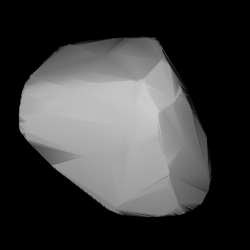
Klymene is a large, dark Themistian asteroid that was discovered by J. C. Watson on September 13, 1868, and named after one of the many Clymenes in Greek mythology. It is orbiting the Sun with a period of 5.60 years and an eccentricity of 0.16. The orbital plane is inclined by 2.8° to the plane of the ecliptic. It is classified as a C-type asteroid, indicating it probably has a carbonaceous composition. The spectra indicates the presence of aqueous-altered minerals on the surface based upon a sharp feature at a wavelength of 3 μm, and, as of 2015, is the only member of the Themis family found to show this absorption.

Camilla is one of the largest asteroids from the outermost edge of the asteroid belt, approximately 250 kilometers in diameter. It is a member of the Sylvia family and located within the Cybele group. It was discovered on 17 November 1868, by English astronomer Norman Pogson at Madras Observatory, India, and named after Camilla, Queen of the Volsci in Roman mythology. The X-type asteroid is a rare trinary asteroid with two minor-planet moons discovered in 2001 and 2016, respectively. It is elongated in shape and has a short rotation period of 4.8 hours.

Lydia is a large belt asteroid with an M-type spectrum, and thus may be metallic in composition, consisting primarily of nickel-iron. It was discovered by French astronomer Alphonse Borrelly on 19 April 1870 and was named for Lydia, the Asia Minor country populated by Phrygians. The Lydia family of asteroids is named after it.

Liberatrix is a main-belt asteroid. It has a relatively reflective surface and an M-type spectrum. Liberatrix is a member of an asteroid family bearing its own name.
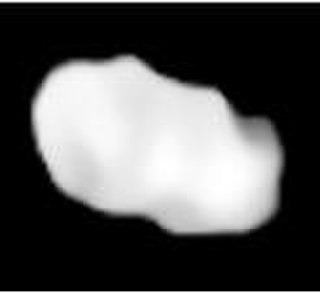
Elektra is a large outer main-belt asteroid and quadruple system with three minor-planet moons. It was discovered on 17 February 1873, by astronomer Christian Peters at Litchfield Observatory, New York, and named after Electra, an avenger in Greek mythology.

175 Andromache is a main-belt asteroid that was discovered by Canadian-American astronomer J. C. Watson on October 1, 1877, and named after Andromache, wife of Hector during the Trojan War. Watson's telegram to Europe announcing the discovery became lost, and so notification did not arrive until several weeks later. As a result, another minor planet, later designated 176 Iduna, was initially assigned the number 175.
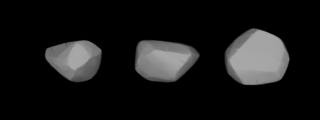
Nausikaa is a large main-belt S-type asteroid. It was discovered by Johann Palisa on February 17, 1879, at Pula, then in Austria, now in Croatia. The name derives from Nausicaä, a princess in Homer's Odyssey.

Prokne is a main-belt asteroid that was discovered by German-American astronomer C. H. F. Peters on March 21, 1879, in Clinton, New York, and named after Procne, the sister of Philomela in Greek mythology. Stellar occultations by Prokne have been observed twice, in 1984 from Italy and again in 1999 from Iowa.

196 Philomela is a large and bright main-belt asteroid. It is an S-type asteroid.

Ampella is a Main belt asteroid that was discovered by Alphonse Borrelly on June 13, 1879. The name seems to be the feminine form of Ampelos, a satyr and good friend of Dionysus in Greek mythology. It could also derive from the Ampelose, a variety of hamadryad. It is an S-type asteroid.

Bianca is a sizeable Main belt asteroid. It is an S-type asteroid. It was discovered by Johann Palisa on 4 September 1880, in Pola and was named after the Austro-Hungarian opera singer Bianca Bianchi. The Vienna newspapers contained several published accounts of the circumstances surrounding the honor extended to the diva in Spring 1882. In the late 1990s, a network of astronomers worldwide gathered lightcurve data that was ultimately used to derive the spin states and shape models of ten new asteroids, including (218) Bianca. The shape model for this asteroid is asymmetrical.

Libussa is a Main belt asteroid that was discovered by C. H. F. Peters on December 22, 1886, in Clinton, New York and was named after Libussa, the legendary founder of Prague. It is classified as an S-type asteroid.
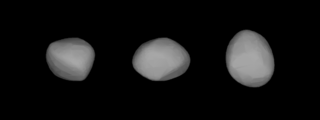
Unitas is a typical main belt asteroid that was discovered by Elia Millosevich on 1 March 1891 in Rome. The asteroid was named by the director of the Modena Observatory in honor of the Italian astronomer Angelo Secchi and the unification of Italy. It is classified as an S-type asteroid.

Polyxo is a main-belt asteroid that was discovered by A. Borrelly on March 31, 1891, in Marseilles. It is orbiting the Sun at a distance of 2.75 AU with a low orbital eccentricity (ovalness) of 0.04 and a period of 4.56 yr. The orbital plane is tilted at an angle of 4.36° to the plane of the ecliptic.
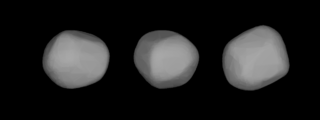
Diotima is one of the larger main-belt asteroids. It is classified as a C-type asteroid and is probably composed of primitive carbonaceous material.
654 Zelinda is a minor planet orbiting the Sun that was discovered on 4 January 1908 by German astronomer August Kopff. On favorable oppositions, it can be as bright as magnitude 10.0, as on January 30, 2016.

679 Pax is a minor planet orbiting the Sun that was discovered by German astronomer August Kopff on January 28, 1909. It is named after Pax, a Roman goddess. It is orbiting the Sun with a period of 4.16 years and an eccentricity of 0.31.

776 Berbericia is a minor planet orbiting the Sun. A main-belt C-type asteroid, it was discovered on 24 January 1914 by astronomer Adam Massinger at Heidelberg Observatory in southwest Germany. It was named by Max Wolf in honor of Adolf Berberich (1861–1920), a German astronomer. The spectra of the asteroid displays evidence of aqueous alteration.
804 Hispania is a minor planet orbiting the Sun. It was discovered from Barcelona (Spain) on 20 March 1915 by Josep Comas Solá (1868–1937), the first asteroid to be discovered by a Spaniard.
980 Anacostia is a minor planet orbiting the Sun that was discovered by American astronomer George Henry Peters on 21 November 1921. The name recognizes the Anacostia River and an historic neighborhood of the same name in the city of Washington D.C.

















